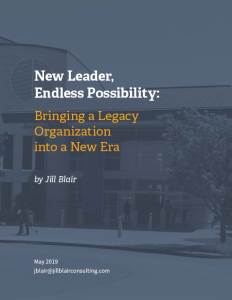New Leader, Endless Possibility: Bringing a Legacy Organization into a New Era
The Challenge
As the Peninsula Jewish Community Center (PJCC) approached its 70th year, it appointed a new CEO and found itself at a pivotal point of transition. As with many legacy organizations, the PJCC had grown, and its service and financial model had shifted over time. An emphasis on sustainability had overtaken its social-purpose roots. The new CEO wanted the institution to undertake a process of intense self-scrutiny: What was the PJCC’s purpose, identity and contribution? To support the process of answering these questions and help steer the PJCC into the future, Jill Blair was enlisted to be a “Maestro of Mayhem,” helping the institution reimagine and reinvigorate itself.
What’s in the Report
Written by Blair, an experienced independent consultant who has evaluated and advised nonprofits and philanthropic organizations on culture, values, leadership, and impact, the report details how she approached her unusual senior fellow role — coaching the new CEO and employing disruption as a strategy to provoke curiosity, prompt new thinking, and increase the organization’s adaptability and comfort with change. The process and lessons Blair documents have relevance for other legacy institutions undergoing transitions in leadership, identity crises and mission drift.
With the “nearly fearless” CEO Paul Geduldig, Blair employed several strategies to disrupt the PJCC, all centered around the questions “What is in the best interest of the institution?” and “Why aren’t we doing that?”. She was able to do so in large part because of the time-limited nature of her task and the position’s freedom from line authority. The experiments she introduced in partnership with the CEO aimed to increase comfort with change and encourage a culture of curiosity. In practical terms, that meant “repurposing” the management team to emphasize learning and leadership. It meant asking everyone across the organization to anonymously and honestly put forth the questions they had wondered but never asked, which revealed informational and functional gaps within and across departments as well as with the board. Efforts like “Crazy Concepts” brought people together across PJCC’s organizational silos in an interdisciplinary quest for solutions to big problems posed by leadership. As a coach, Blair provided Geduldig with weekly feedback on his leadership in pursuit of the organization’s best interest, and coordinated quarterly “brain jams,” effectively day-long off-site opportunities for self-assessment and deep learning.
“It is possible to retrieve and revive legacy institutions by facilitating engagements between seasoned professionals, who have developed courage and methods of managing over time, and the rising generation of leaders, who bring fresh energy, vision, and commitment to the table.”
Jill Blair
Blair’s key takeaways is that the intentions — to help a leader and an organization ask questions, experiment and learn — are more important than the particulars of the disruptions. The report ends with reflections from the CEO about the insights he gained, what made the senior fellow role successful, and the practices he found most valuable.
